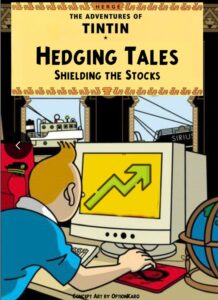In this post we will talk about reasons as to why you should explore options. Doesn’t matter who you are, you could be an investor or a trader, options as a product has something for everyone.
In this world full of experts advising retail investors to stick to passive investing, I urge you to do that and more. Here are five reasons why.
Options are strategic products
If you have been in stock markets, you know you can buy stocks of companies listed on the exchange. It’s simple. But low and sell high—at least conceptually, it’s simple.
But what if you want to be more ‘strategic’? What if you want to structure your investments with a non-linear payoff?
I know by now you would be yelling at me – “Sandeep, stop this mumbo jumbo and explain it to me like I am a five-year-old.”
What is a non-linear payoff? – Say you have eight lakhs invested in the markets, maybe through mutual funds and stocks. The market has been kind, and your investments are at ten lakhs today.
At this point, you say – I don’t want to lose any money I have made. I am okay to make more if the markets go up, but I don’t want to lose any of my money if the market crashes. Options can help you structure a trade like that.
That’s one example of what a non-linear payoff looks like. You can create many such nuanced structures for any possible future scenario.
Options are multidimensional
If you are an investor in stocks, you can take advantage of only one dimension of the market, i.e., of the market going up.
Options pricing, the way it works, helps you profit from many market mechanics. You can use option pricing factors like delta, volatility and theta decay to your advantage.
For example, a part of the option price comprises what is known as ‘time value’. In a simplistic sense, if the market doesn’t move anywhere, this ‘time value’ decays, and you can profit from it.
Options are capital-efficient
If you have ten lakhs worth of stock and the value of those stocks goes up, you make some returns on it. Thats all.
With options, you can take multiple approaches to be more efficient with capital. This efficiency comes because options are inherently leveraged products.
Taking NIFTY’s example would help.
Assuming we buy a 20000 CE option, which is priced at Rs.200, we are paying 200*50 = 10k in favour of a contract with a 20000*50 = 10 Lakh value.
As an Option Buyer, you only need to invest a small fraction to take a position equal to the shares.
As an Option Seller, you get some additional benefits. You can first own and then pledge the shares. This way, you can use your investment in holding the shares to trade options.
Options allow you to hedge your investments
Think of options as term insurance.
If you have investments in stocks or equity mutual funds and want to avoid a downside risk, all you need to do is buy puts to insure your portfolio against a crash.
There is a learning curve regarding the mechanics, but it’s no rocket science.
Options offer ways to make your passive investments work harder
Conventional wisdom and financial literacy programs stop with saying investing in equities and fixed-income products would do good for you in the long run. Fair point.
But if you are willing and curious to manage your money better, you should aim for more, especially if you are young and starting your career and investing journey.
Remember, passive investing guarantees that you will always underperform the benchmarks, nor do you have a chance to outperform the benchmarks, and fixed-income products? They would barely cover inflation.
Bottomline – If you are serious about generating alpha and making your passive investments work harder, you must consider options.
NOTE: This article is purely for informational purposes only and not a recommendation.






